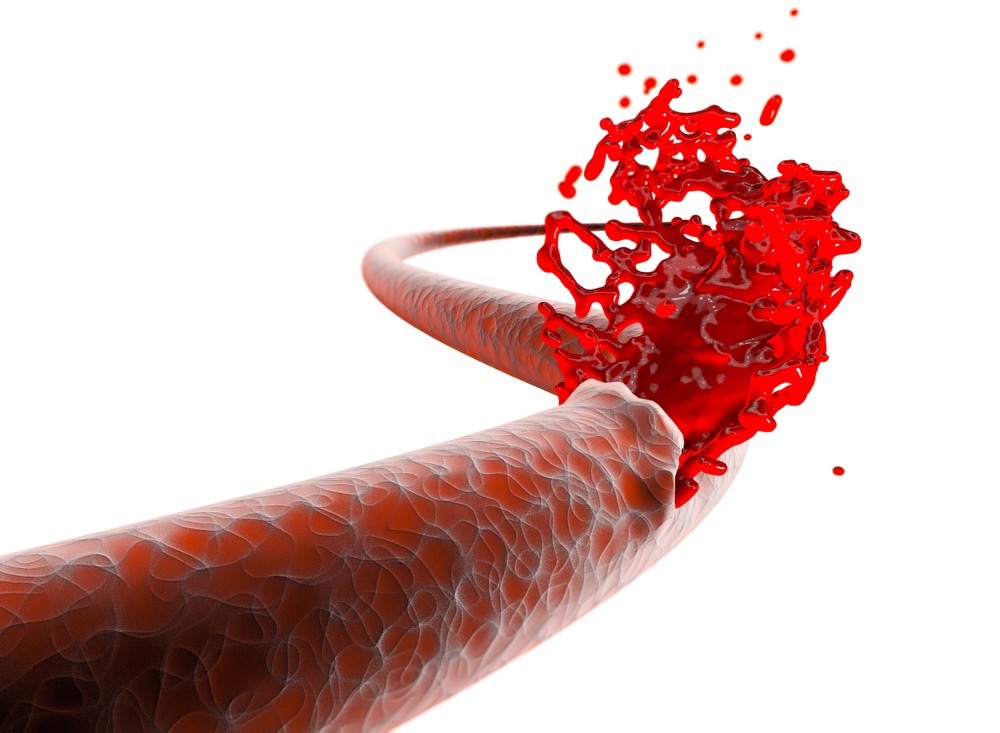An uncontrolled hemorrhage could lead to detrimental consequences. Despite the significant advances in hemostatic research, there is still an urgent need for safer and more effective hemostatic materials.

Study: Water-Swellable Cellulose Nanofiber Aerogel for Control of Hemorrhage from Penetrating Wounds. Image Credit: Naeblys/Shutterstock.com
An article published in the journal ACS Applied Bio Materials reported a citric acid-cross-linked carboxymethyl cellulose nanofiber (CA-CMCNF) aerogel that can control the bleeding from penetrating wounds. CA-CMCNF is a compressed aerogel that rapidly swells into its native shape in the water.
The compressed aerogel had the maximum volume and mass expansion ratios of over 3000 and 6800%, respectively. The water-swellable property of the prepared compressed aerogel enabled its self-expansion and filled in the wound cavities.
Here, the in situ-generated expansion pressure opposed the systolic blood pressure. Moreover, carboxyl groups on the aerogel stimulated the active coagulation pathway and enabled the hemostatic capability of the aerogel. In addition to the hemostatic effect, the compressed aerogel showed an outstanding antibacterial property and good biocompatibility.
Application of the prepared compressed aerogel in animal experiments with liver penetrating animal models revealed its efficiency in reducing the hemostasis time and the amount of bleeding. Thus, the present study offered a safe and robust water-swellable compressed aerogel with excellent hemostatic properties for controlling bleeding from penetrating wounds.
Materials Promoting Hemostasis of Penetrating Wounds
Uncontrolled hemorrhages are commonly associated with civilian accidents or surgical settings. The native coagulation pathway gets activated at the onset of bleeding to prevent hemorrhage from deep wounds causing vascular traumas.
Excessive bleeding can cause severe damage, including hemorrhagic shock, hypothermia, hypotension, multiple organ failure, acidosis, and infections. The uncontrollable bleeding is of two types: compressible (external injuries to limb and torso) and non-compressible wounds (traumas in the junctional areas and subdermal/internal vascular injuries). Thus, hemostasis becomes a crucial step in trauma treatment.
In this regard, hemostatic nanotechnologies have been applied to further advance the development of hemostatic materials, with a wide variety of hemostatic nanomaterials constantly emerging. As the top priority, an ideal hemostat should exhibit excellent biocompatibility and biosafety. It should also be easy to manipulate and rapidly halt bleeding, seal off wounds, promote wound healing and tissue regeneration, and exhibit antimicrobial properties.
Compared to conventional hemostatic materials, hemostatic nanomaterials possess a larger surface area and yield a nanoscale effect that can facilitate blood absorption and cell adhesion. Furthermore, the physicochemical properties of hemostatic nanomaterials, such as size, surface, shape, and flexibility, are adjustable, making it easier to customize hemostats for various scenarios.
Furthermore, shape-adaptive hemostatic materials are ideal for hemorrhage control in penetrating wounds with irregular and deep cavities. Xstat was the first shape-adaptive hemostatic material introduced for hemorrhage control in penetrating wounds.
Xstat was a self-expandable material composed of a compressed cellulose/chitosan sponge injected into a wound to conform to the cavity and prevent excessive blood loss. However, this material has two drawbacks: longer expansion time and a low water absorption ratio.
Hemostasis in Penetrating Wounds Using CA-CMCNF Aerogel
This study developed a water-swellable compressed aerogel based on cellulose to control hemorrhage in penetrating wounds. Here, lyophilization of a mixture of CMCNFs and CA was performed, followed by heating resulting in the CA-CMCNF hybrid aerogel.
The prepared hybrid aerogel was compressed into a solid pellet, and its exposure to water resulted in rapid swelling into its original shape. However, the CMCNF aerogel alone could not restore its original shape in the water, indicating that CA was essential for self-expansion.
When injected into a penetrating wound, the compressed aerogel conformed well to the wound cavity, exerting internal pressure to oppose the systolic blood pressure. Moreover, this compressed aerogel could promote hemostasis and display antibacterial functions owing to several carboxyl groups on its surface. Finally, compared to QuikClot combat gauze, the CA-CMCNF aerogel showed better hemostatic capability in a rabbit liver-penetrating model.
Conclusion
CMCNFs and CA biocompatible components were used to prepare a water-swellable hemostatic aerogel via lyophilization and subsequent heating. CA-CMCNF aerogel was compressed into a solid pellet that could rapidly swell and recover its native shape in the water.
However, the compressed CMCNF aerogel alone could not re-establish its original shape, indicating that CA is necessary for self-expansion. Here, CA had two functions; to cross-link CMCNFs and protonate carboxyl groups of CMCNFs. Thus, the protonation of carboxyl groups was responsible for water-swellable behavior.
To strengthen the structure and enable the free flow of water through the compressed aerogel during self-expansion, the protonated carboxyl groups established double hydrogen bonds in the walls of the aerogel microchannels.
Furthermore, several carboxyl groups on CA-CMCNF aerogel endowed them with excellent antibacterial and procoagulant capabilities. Thus, CA-CMCNF aerogel was presented as promising hemostatic material in a liver penetrating wound model.
Reference
Wang, L et al. (2022). Water-Swellable Cellulose Nanofiber Aerogel for Control of Hemorrhage from Penetrating Wounds. ACS Applied Bio Materials. https://pubs.acs.org/doi/full/10.1021/acsabm.2c00609
Disclaimer: The views expressed here are those of the author expressed in their private capacity and do not necessarily represent the views of AZoM.com Limited T/A AZoNetwork the owner and operator of this website. This disclaimer forms part of the Terms and conditions of use of this website.